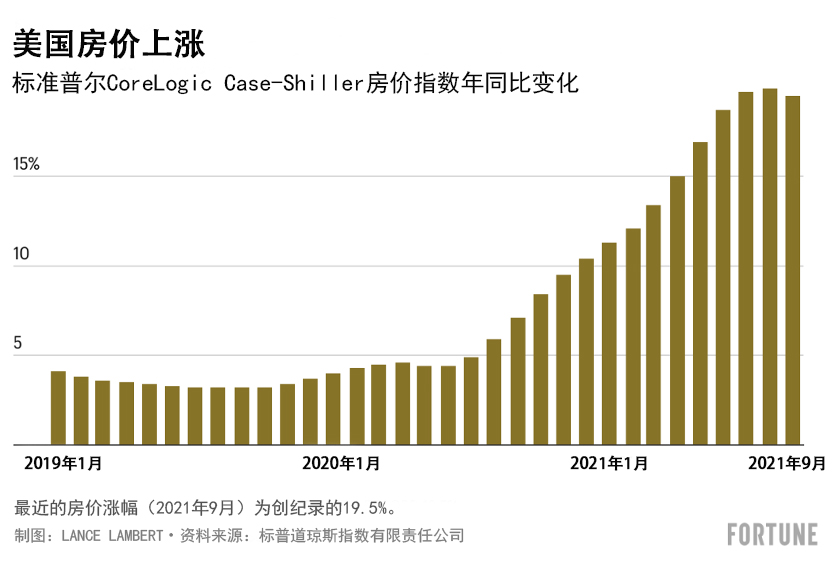精疲力竭。失望沮丧。捉襟见肘。这些都是购房人目前的一些合理感受。毕竟,美国今年的房价上涨速度已经创下了有史以来的最高纪录:从2020年8月到2021年8月,美国房价上涨19.8%,为史上最大涨幅,远高于2008年房地产市场崩溃前12个月的最高水平(14.1%)。
但对于购房人而言,现在也有一些好消息。作为衡量住宅房地产价格的主要指标,标准普尔CoreLogic Case-Shiller指数的最新数据发现,2020年9月至2021年9月期间,美国房价同比上涨了19.5%。房价涨幅小幅下降了0.3%,是近两年来首次出现房价上涨减速。
这种小幅下降乍一看似乎微不足道。但仔细研究这些数据你会发现,其意义远比数据本身所显示的更加重要。虽然房价年同比上涨19.5%,但大部分都是发生在今年房地产市场最火爆的春夏两季。事实上,9月房价环比涨幅只有1.18%,远低于维持19.5%的年收益率所需要达到的价格涨幅。
而且房价上涨减速才刚刚开始。至少接受《财富》杂志采访的业内人士都这样认为。到底发生了什么?今年秋季,美国房地产市场受到季节性因素的影响,增长速度开始放缓。在每年节假日季期间,美国房地产市场通常会有所降温,但去年市场并没有受到这种因素的影响。此外,面对高企的房价,一些潜在购房人终于开始选择观望。这种状况已经持续了几个月,但滞后的销售数据意味着我们需要过一段时间才能真正看到首次房价上涨减速。

虽然房地产行业都认为房价上涨将继续减速,甚至15.1%的增长率也难以持久,但业内对于2022年美国房价上涨的幅度却无法达成共识。
在《财富》杂志上周分析的七个行业预测模型中,Zillow的模型最为乐观。该在线房地产交易网站预测,2021年10月至2022年10月期间,美国房价将上涨13.6%。Zillow预测的房价涨幅将比当前水平下降5.9个百分点,但这并不代表购房人对于房价的焦虑能够得到缓解。毕竟,尽管当前劳动力市场火爆,但平均年度加薪幅度依旧只有3%。同时,高盛(Goldman Sachs)(按年度计算涨幅为13.5%)、房利美(Fannie Mae)(7.9%)和房地美(Freddie Mac)(7%)的12个月房价预测也都认为明年美国房价将维持强劲增长的势头。

但并非所有人都认为美国房价上涨速度会继续高于历史水平(自1980年以来平均涨幅为4.6%)。比如Redfin预测房价涨幅将下降到3%。CoreLogic预测房价涨幅将下降到1.9%,抵押贷款银行家协会(Mortgage Bankers Association)预测现房中位数房价将下跌2.5%。
如果抵押贷款银行家协会、CoreLogic或Redfin的经济学模型的预测成真,是否将给购房人一些喘息的机会?在价格方面确实如此,但总体成本并没有变化。
这三个模型之所以更不看好房价上涨趋势,是因为他们认为明年抵押贷款利率会快速上浮。Redfin预测,到2022年底,现行的30年平均固定抵押贷款利率将从3.1%上浮到3.6%,抵押贷款银行家协会预测的利率为4%。随着抵押贷款利率上浮,购房人的贷款利息增加,实际上将抵消房价增速下降的影响(即房价涨幅不会达到Zillow预测的13.6%)。(财富中文网)
译者:刘进龙
审校:汪皓
精疲力竭。失望沮丧。捉襟见肘。这些都是购房人目前的一些合理感受。毕竟,美国今年的房价上涨速度已经创下了有史以来的最高纪录:从2020年8月到2021年8月,美国房价上涨19.8%,为史上最大涨幅,远高于2008年房地产市场崩溃前12个月的最高水平(14.1%)。
但对于购房人而言,现在也有一些好消息。作为衡量住宅房地产价格的主要指标,标准普尔CoreLogic Case-Shiller指数的最新数据发现,2020年9月至2021年9月期间,美国房价同比上涨了19.5%。房价涨幅小幅下降了0.3%,是近两年来首次出现房价上涨减速。
这种小幅下降乍一看似乎微不足道。但仔细研究这些数据你会发现,其意义远比数据本身所显示的更加重要。虽然房价年同比上涨19.5%,但大部分都是发生在今年房地产市场最火爆的春夏两季。事实上,9月房价环比涨幅只有1.18%,远低于维持19.5%的年收益率所需要达到的价格涨幅。
而且房价上涨减速才刚刚开始。至少接受《财富》杂志采访的业内人士都这样认为。到底发生了什么?今年秋季,美国房地产市场受到季节性因素的影响,增长速度开始放缓。在每年节假日季期间,美国房地产市场通常会有所降温,但去年市场并没有受到这种因素的影响。此外,面对高企的房价,一些潜在购房人终于开始选择观望。这种状况已经持续了几个月,但滞后的销售数据意味着我们需要过一段时间才能真正看到首次房价上涨减速。
虽然房地产行业都认为房价上涨将继续减速,甚至15.1%的增长率也难以持久,但业内对于2022年美国房价上涨的幅度却无法达成共识。
在《财富》杂志上周分析的七个行业预测模型中,Zillow的模型最为乐观。该在线房地产交易网站预测,2021年10月至2022年10月期间,美国房价将上涨13.6%。Zillow预测的房价涨幅将比当前水平下降5.9个百分点,但这并不代表购房人对于房价的焦虑能够得到缓解。毕竟,尽管当前劳动力市场火爆,但平均年度加薪幅度依旧只有3%。同时,高盛(Goldman Sachs)(按年度计算涨幅为13.5%)、房利美(Fannie Mae)(7.9%)和房地美(Freddie Mac)(7%)的12个月房价预测也都认为明年美国房价将维持强劲增长的势头。
但并非所有人都认为美国房价上涨速度会继续高于历史水平(自1980年以来平均涨幅为4.6%)。比如Redfin预测房价涨幅将下降到3%。CoreLogic预测房价涨幅将下降到1.9%,抵押贷款银行家协会(Mortgage Bankers Association)预测现房中位数房价将下跌2.5%。
如果抵押贷款银行家协会、CoreLogic或Redfin的经济学模型的预测成真,是否将给购房人一些喘息的机会?在价格方面确实如此,但总体成本并没有变化。
这三个模型之所以更不看好房价上涨趋势,是因为他们认为明年抵押贷款利率会快速上浮。Redfin预测,到2022年底,现行的30年平均固定抵押贷款利率将从3.1%上浮到3.6%,抵押贷款银行家协会预测的利率为4%。随着抵押贷款利率上浮,购房人的贷款利息增加,实际上将抵消房价增速下降的影响(即房价涨幅不会达到Zillow预测的13.6%)。(财富中文网)
译者:刘进龙
审校:汪皓
Exhausted. Frustrated. Stretched. Those are all reasonable emotions for home shoppers to be feeling right now. After all, home prices rose faster this year than any period in tabulated U.S. history: Between August 2020 and August 2021, U.S. home prices notched a 19.8% gain—the largest uptick on record, and well above the 12-month peak (14.1%) in the lead-up to the 2008 housing crash.
But there's a bit of good news for homebuyers. The latest reading of the S&P CoreLogic Case-Shiller Index, the leading measure of residential real estate prices, finds year-over-year U.S. home prices rose 19.5% between September 2020 and September 2021. That slight 0.3% dip marks the first price growth deceleration in nearly two years.
At first glance, that tiny dip hardly looks significant. However, a closer look at the numbers shows this deceleration is larger than the top-line figure would suggest. While home prices are up 19.5% year over year, most of that uptick occurred back during the red-hot stretch this spring and summer. Indeed, the month-over-month jump in September was just 1.18%, which is far below the pace prices would need to rise to maintain a 19.5% annual rate of return.
And this deceleration in home price increases is just getting started. At least that's what industry insiders are telling Fortune. What's going on? This fall the housing market began to slow down a bit as seasonality—a cooling period that happens most years around the holiday and vacation season—returned to the market after it was absent last year. Additionally, some would-be homebuyers finally started balking at sky-high prices. This has been happening for a few months, however, and lagging sales data means we had to wait a while to see that first price deceleration on paper.
While there's a consensus in the real estate industry that price growth will continue to decelerate—even a 15.1% growth rate simply isn't sustainable long term—there is not a consensus of what the rate of U.S. home price growth will look like in 2022.
Among the seven industry forecast models that Fortune reviewed last week, Zillow's model was the most bullish. The online listing site is predicting prices will rise another 13.6% between October 2021 and October 2022. While Zillow's forecast would represent a 5.9 percentage point deceleration from the current top-line figure, it would hardly represent price relief. After all, even in this hot labor market, the average annual raise is still only 3%. Similarly, 12-month forecasts by Goldman Sachs (13.5% on an annualized basis), Fannie Mae (7.9%), and Freddie Mac (7%) all foresee home price growth remaining fairly strong next year.
But not everyone thinks price growth will remain evaluated above historical levels of price appreciation (up on average 4.6% since 1980). Look no further than Redfin, which is predicting price growth will fall to 3%. Meanwhile, CoreLogic foresees price growth slowing to 1.9%, and the Mortgage Bankers Association forecast the median price of existing homes will actually decrease by 2.5%.
If the economic models produced by the Mortgage Bankers Association, CoreLogic, or Redfin come to fruition, it would give buyers some breathing room, right? That would be true on the price front; however, the overall cost could be the same.
The reason these three models are more bearish on prices is because they believe that mortgage rates will rise fairly quickly next year. Redfin predicts the current 30-year average fixed mortgage rate will climb from 3.1% to 3.6% by the end of 2022, while the Mortgage Bankers Association forecasts 4%. At that increased mortgage rate, the price savings (that is, not growing by the 13.6% rate predicted by Zillow) would essentially get wiped out by added interest to the loan.






